Lessico
Cigno
nero
Cygnus atratus
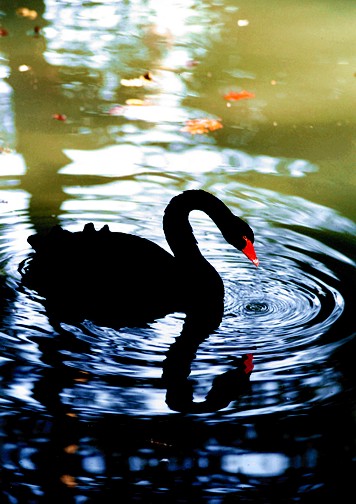
Cigno
nero - Cygnus atratus
foto di Guido Comasini![]() - 1996
- 1996
Ignota
la sostanza
che dà il colore rosso al becco
Si può affermare che ancora oggi, giovedì 28 agosto 2009, non conosciamo la sostanza che determina la colorazione rossa del becco del Cygnus atratus, anche se possiamo presumere trattarsi di un carotenoide. Ce lo conferma il Dr Geoffrey Hill, Department of Biological Sciences Auburn University (Alabama – USA) che così mi ha risposto via email:
Elio, to my knowledge, the bill tissue of that bird has never been tested. The list of carotenoid content of bird feathers and bills in Kevin McGraw's chapter in my book Bird Coloration, is a complete list of what we know. Geoffrey.
Miocardite
con rottura del ventricolo
in Cygnus atratus
Black Swan
Scientific
classification
Kingdom: Animalia
Phylum: Chordata
Class: Aves
Order: Anseriformes
Family: Anatidae
Genus: Cygnus
Species: Cygnus atratus
Binomial name Cygnus atratus (Latham, 1790)
The Black Swan, Cygnus atratus, is a large waterbird which breeds mainly in the southeast and southwest regions of Australia. The Black Swan was formerly placed into a monotypic genus, Chenopis.
‘Swan’ is the common gender term, but ‘cob’ for a male and ‘pen’ for a female are also used, as is ‘cygnet’ for the young. Collective nouns include a ‘bank’ (on the ground) and a ‘wedge’ (in flight). Black Swans can be found singly, or in loose companies numbering into the hundreds or even thousands.
Description
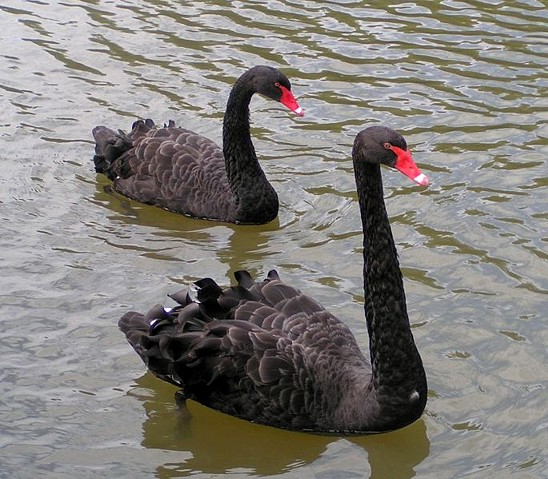
Black Swans are mostly black feathered, with a line of white flight feathers of the wing edges that sometimes show when at rest, and are conspicuous in flight. The bill is bright red, with a pale bar and tip; and legs and feet are greyish-black. Cobs (males) are slightly larger than pens (females), with a longer and straighter bill. Cygnets (immature birds) are a greyish-brown with pale-edged feathers.
A mature Black Swan measures between 1.1 and 1.4 metres in length and weighs up to 9 kg. Its wing span, in flight, is between 1.6 and 2 metres. The neck is long (relatively the longest neck among the swans) and curved in an "S".
The Black Swan utters a musical and far reaching bugle-like sound, called either on the water or in flight, as well as a range of softer crooning notes. It can also whistle, especially when disturbed while breeding and nesting.
The Black Swan is unlike any other Australian bird, although in poor light and at long range it may be confused with a magpie-goose in flight. However the Black Swan can be distinguished by its much longer neck and slower wing beat.
Distribution
www.bsc-eoc.org/avibase/
The species has a large range, with figures between one to ten million km² given as the extent of occurrence. The current global population of the Black Swan is estimated to be up to 500,000 individuals. No threat of extinction, or significant decline in population has been identified in this numerous and widespread bird.
The Black Swan is common in the wetlands of south western and eastern Australia and adjacent coastal islands. In the south west the range encompasses an area between North West Cape, Cape Leeuwin and Eucla; while in the east it covers are large region bounded by the Atherton Tableland, the Eyre Peninsula and Tasmania, with the Murray Darling Basin supporting very large populations of Black Swans. It is uncommon in central and northern Australia.
The Black Swan’s preferred habitat extends across fresh, brackish and salt water lakes, swamps and rivers with underwater and emergent vegetation for food and nesting materials. Permanent wetlands are preferred, including ornamental lakes, but Black Swans can also be found in flooded pastures and tidal mudflats, and occasionally on the open sea near islands or the shore.
Black Swans were once thought to be sedentary, but the species is now known to be highly nomadic. There is no set migratory pattern, but rather opportunistic responses to either rainfall or drought. In high rainfall years, emigration occurs from the south west and south east into the interior, with a reverse immigration to these heartlands in drier years. When rain does fall in the arid central regions, Black Swans will migrate to these areas to nest and raise their young. However, should dry conditions return before the young have been raised, the adult birds will abandon the nests and their eggs or cygnets and return to wetter areas.
Black Swans, like many other water fowl, lose all their flight feathers at once when they moult after breeding, and they are unable to fly for about a month. During this time they will usually settle on large, open waters for safety.
Introduced populations
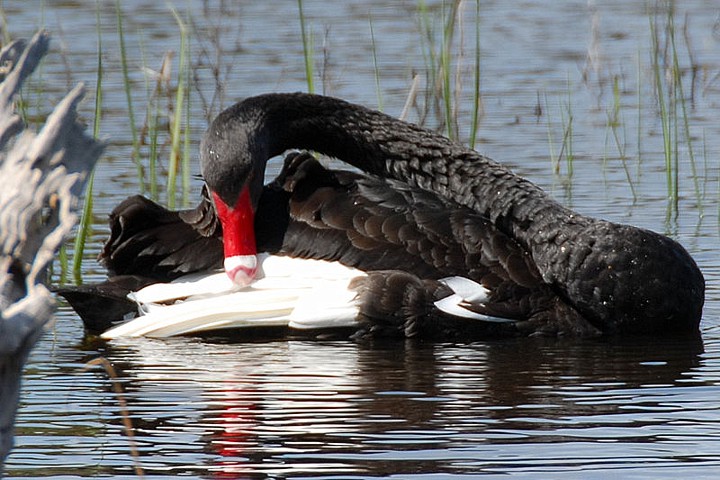
Prior to the arrival of the Maori in New Zealand, a sub-species of the Black Swan known as the New Zealand Swan had developed in the islands, but was apparently hunted to extinction. In 1864 the Australian Black Swan was introduced to New Zealand as an ornamental waterfowl, and populations are now common on larger coastal or inland lakes, especially Rotorua Lakes, Lake Wairarapa and Lake Ellesmere, and the Chatham Islands. Black Swans have also naturally flown to New Zealand, leading some people to consider them a native rather than exotic species, although the present population appears to be largely descended from deliberate introductions.
The Black Swan is also very popular as an ornamental waterbird in Western Europe, especially Britain, and escapes are commonly reported. As yet the population in Britain is not considered to be self-sustaining and so the species is not afforded admission to the official British List, but the Wildfowl and Wetlands Trust have recorded a maximum of nine breeding pairs in the UK in 2001, with an estimate of 43 feral birds in 2003/04 (though that is undoubtedly an under-estimate given the level of monitoring undertaken).
Behaviour
Bearing - When swimming, Black Swans hold their necks arched or erect, and often carry their feathers or wings raised in an aggressive display. In flight, a wedge of Black Swans will form as a line or a V, with the individual birds flying strongly with undulating long necks, making whistling sounds with their wings and baying, bugling or trumpeting calls.
Nesting - Generally, Black Swans nest in the wetter winter months (February to September), occasionally in large colonies. A typical clutch contains 4 to 7 greenish-white eggs that are incubated for about 35-40 days. After hatching the cygnets are tended by the parents for about 6 months until fledging, and may ride on their parent's back for longer trips into deeper water.
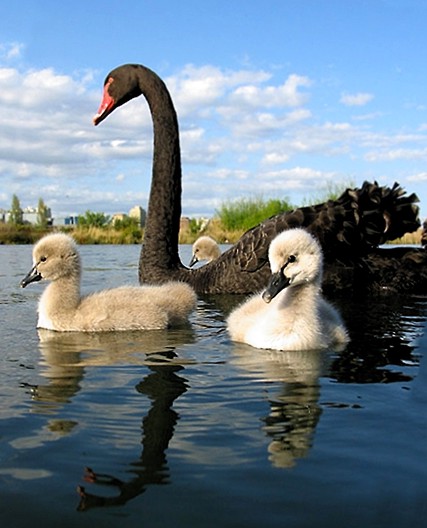
A Black Swan nest is essentially a large heap or mound of reeds, grasses and weeds between 1 and 1.5 metres in diameter and up to 1 metre high, in shallow water or on islands. A nest is reused every year, restored or rebuilt as needed. Both parents share the care of the nest. Like other swans, the Black Swan is largely monogamous, pairing for life (about 6% divorce rate). Recent studies have shown that around a third of all broods exhibit extra-pair paternity.
Sexuality - A recent (2007) exhibition at the University of Oslo Natural History Museum in Norway called Against Nature? explored homosexual behaviours in a number of species, including Black Swans.
Several swan species exhibit lifelong homosexual behaviours, and the same phenomenon can also be found in a number of other water-birds, notably geese and flamingos, where it serves as a flexible life strategy.
In swans, the pair is the central social unit. The birds reinforce the unit with frequent preening and sex. Should one die, the other will usually live out the remainder of its life alone. The pair builds nests, raise cygnets and defends a territory. Two cobs, being bigger and stronger than a cob and a pen, can hold down a larger territory, and provide their cygnets with more to eat.
Such homosexual pairs represents a major fitness bonus to a pen, and pens without partners will seek out these couples, have sex with one or other of the cobs and lay eggs in their nest. She is then chased off, not being a part of the pair, and the cobs raise the cygnets themselves. Having access to more food the brood have up to ten times the survival rate of a brood with a heterosexual swan couple. From an evolutionary point of view, this is a very rewarding strategy for the cobs as well.
This situation only holds true as long as a nest and a territory is in short supply. The two males will have a fitness loss in that they have no guarantee they are the actual fathers of the cygnets (not being bonded with the female) and will anyway have to split reproduction between them.
A homosexual lifestyle will be advantageous in some situations, but not in others. However, having a partner is a requisite for building a nest and keeping a territory, and an opposite sex partner may not always be available when forming pairs. Thus, the ability to form a homosexual male pair is a normal part of the Black Swans social behaviour and an example of a flexible life strategy in the species.
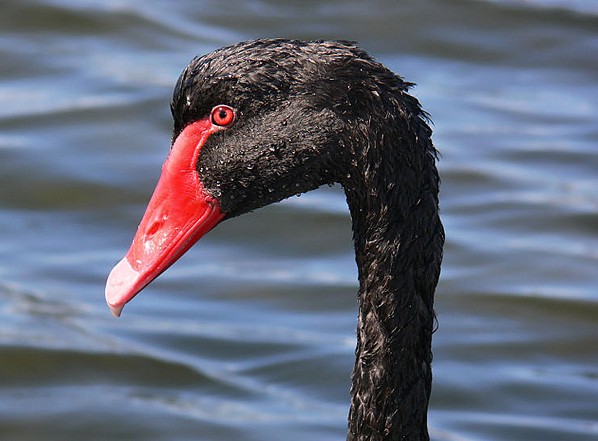
Conservation
The Black Swan is protected under the Australian National Parks and Wildlife Act, 1974. The Black Swan is evaluated as Least Concern on the IUCN Red List of Threatened Species.
Australian culture
The black swan was a literary or artistic image, even before the discovery of Cygnus atratus. Cultural reference has been based on symbolic contrast and as a distinctive motif. The Black Swan's role in Australian heraldry and culture extends to the first founding of the colonies in the eighteenth century. It has often been equated with antipodean identity, the contrast to the white swan of the northern hemisphere indicating 'Australianess'. The black swan is featured on the flag, and is both the state and bird emblem, of Western Australia; it also appears in the Coat of Arms and other iconography of the state's institutions.
Le immagini che seguono stanno a dimostrare che i miei cigni neri si sono non solo addomesticati, ma se lasciassi la porta aperta entrerebbero in casa. Ecco perché li ho battezzati casalinghi.
Ne sono una riprova le feci che vengono a deporre a pochi centimetri dall'uscio, dove stanno a cincischiare per ore. Inoltre, anche se le due uova - di cui uno avitellino - sono state deposte nel loro recinto dopo ben 10 anni dall'arrivo nella mia tenuta, la femmina, quella in primo piano con anello alla zampa sinistra, ha costruito un nido rudimentale nei pressi dell'annaffiatoio, a un metro dall'ingresso di casa, lì dove appare nella foto.
Il peso delle uova era rispettivamente di 105 grammi per quello senza tuorlo deposto il 9 marzo 2007, di 320 grammi per quello normale deposto il 12 marzo 2007. Poi la deposizione è cessata. Vedremo cosa accadrà nel 2008, o se dovremo attendere ancora 10 anni.
La
mia coppia di Cygnus atratus di età sconosciuta
fu acquisita a Varese nel 1997.
Allo stato selvatico il Cygnus atratus
ha una durata di vita dai 3 ai 6 anni.
In cattività la durata di vita può raggiungere e superare i 20 anni.
Lunedì 4 luglio 2011 trovo il maschio morto che seppellisco mercoledì 6
luglio.
Lei, la Gnona (come la chiamo), oggi giovedì 13 aprile 2017
quando ha almeno 20 anni d’età
è ancora viva e vivacissima.
foto di Elio Corti - 2007
Venerdì
9 marzo 2007 - primo uovo azzurrino abortivo della cigna
Lunedì 12 marzo 2007 - secondo uovo azzurrino ma normale della cigna
Uova
azzurre di Cygnus atratus
paragonate con uova di anatra.
L'uovo di cigno più piccolo - 105 g - era avitellino. Deposto il 9 marzo 2007
all'età di 10 anni.
Quello normale pesava 320 g. Deposto il 12 marzo 2007.